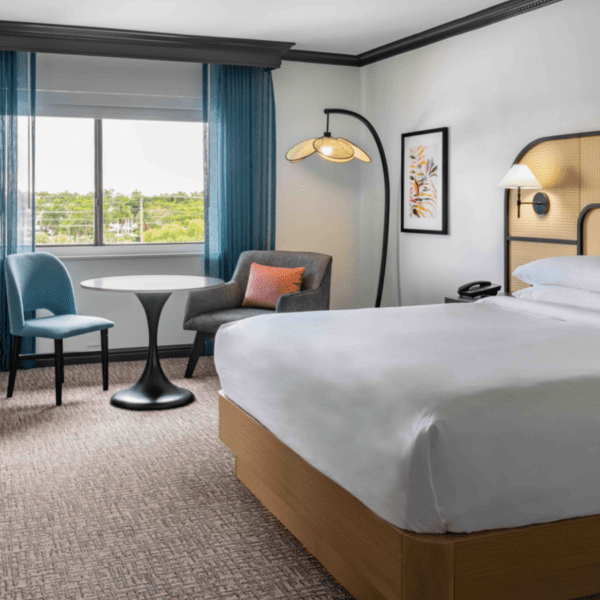 Only in New York…as they said in the antecovidian times. Pandemics and a swath of property bankruptcies across the island can change that, though. But there’s a light at the end of the tunnel and many smaller, nimbler hotels are offering a good case study in innovation. First, we ask, though, who is Roger Smith?
Only in New York…as they said in the antecovidian times. Pandemics and a swath of property bankruptcies across the island can change that, though. But there’s a light at the end of the tunnel and many smaller, nimbler hotels are offering a good case study in innovation. First, we ask, though, who is Roger Smith?
As the titular hotel’s Director of Marketing and Co-Owner, John Knowles, jocularly explained during our time together, the enigmatic ‘Roger’ is many things to many people. Located at the corner of 47th and Lexington and surrounded by a myriad of competitors, the personified alias that has given this Midtown Manhattan property its name has always represented a place where great ideas are born and where bold actions are made reality. Now, however, the 136-room Roger Smith Hotel offers an archetypical example of a trendsetting post-Covid adaptation in a major urban center, and hoteliers would be wise to take note.
With the multitude of hotels on the island all looking for new routes for profitability, an independent such as the Roger Smith that has kept its doors closed throughout the summer has had to pivot quickly and smartly to stay afloat, especially as more hotels relaunch into the marketplace. The solution was to capitalize upon the emerging customer demand to work from a hotel.
Since the initial lockdown in March, like all other intrepid hoteliers, Knowles started to look at how the market would evolve and how it would resurface once the work-from-home orders were relaxed. The first step was obviously to implement new sanitization procedures as well as adding touchless technologies wherever possible so as to safeguard the staff as well as customers once they start to return. These include online pre-check-in and platforms to expedite upfront payments – anything in an effort to ensure social distancing in the lobby.
But those upgrades alone have proven to be not nearly enough to bring guests back; the product itself had to evolve. Chiefly, it was apparent by early June that international and even domestic travelers to the Big Apple – business, leisure or otherwise – would not be returning to their 2019 peak levels anytime in our current calendar year. This in turn meant that the Roger Smith had to position itself for mostly local and regional guests – that is, only the tristate area.
With spring shifting into summer, the biggest observation from being on the ground in New York was that working remotely was here to stay. As a consequence, though, many were already growing weary of conducting business in the same place as where they ate and slept – JP Morgan being one such behemoth company that has publicly stated as such. Not only is the work-from-home expectation rapidly going out of style, but companies are discovering that a fresh environment can sharply increase employee morale and, sometimes, productivity. Concurrently, many businesses are getting out of their office leases which are no longer financially practical, yet they still need space to occasionally regroup.
If hotels are to fill the void of transitional office spaces, they have to address several criteria including:
- Rooms must have separate areas specifically designated as bedrooms and offices
- Executives or any other businesspersons need space to think and break out in private
- Suites or connected rooms work best as they can be used for small group meetings
- Rooms must have a full range of amenities to accommodate extended stays
- Furnishings must be minimized to streamline cleaning load and thus increase sanitization
- Despite these removals, furnishings must still create a luxurious and inspirational setting
- Contactless technologies must be in place for both guest and employee safety
- Hotels must be able to cordon off certain sections or floors for groups to limit contact
The retrofit of the Roger Smith to meet these conditions began in early July 2020, and due to many of the preexisting suitability for both rooms and suites in catering to the business executive guest persona, the necessary inventory conversions were finished by early August, including kitchenettes in some guestrooms. Attention to detail in both design and aesthetics is a top driver for this market segment, and thus only 22 rooms were reactivated at launch in early September to ensure that the new concept meets the expectations of post-pandemic guests and to appropriately manage staffing.
Testing with pilot groups occurred throughout August, with the hope being to incrementally reopen more rooms once all the kinks were ironed out and the best distribution channels were identified for this work-from-hotel model. This stepwise approach to reopening allowed the Roger Smith Hotel to package its better inventory to drive direct bookings or for sale as part of a joint presentation. In this sense, this pivot was also a chance to rethink how the property utilized the OTAs.
Complementing this regional focus was a sense of community engagement where the hotel could be viewed as an active innovator in contrast to numerous other properties that were taking a wait-and-see approach (or those that were preparing to shut their doors forever). To help line up revenues, the sales team actively looked for partnership opportunities and local companies in need of a safe meeting and living space for a small collection of executives, with a primary emphasis on building relationships lasting through the winter months rather than one-off contracts.
Ultimately, September was the true test for new adaptations to the next normal like the Roger Smith Hotel as this is the month when the traditional back-to-school mentality drives more executives to search for creative solutions. Thus, it’s critical during this transition into autumn (and out of peak summer leisure travel) to establish good collaborations with companies so that corporate bookings are consistent, or even increase, throughout the fourth quarter and into 2021. The plan that Knowles has taken for the Roger Smith Hotel demonstrates a very lucrative way to capitalize on the now underserved business guest in need of a local workplace getaway.



















